A well-fitted pool cover serves as a valuable barrier, safeguarding your pool from debris, maintaining water cleanliness, and conserving heat. However, one common issue that pool owners encounter is the sagging of their pool cover.
When a cover sags, it can compromise its effectiveness and lead to potential damage. Fortunately, there are practical steps you can take to prevent pool cover sagging and maximize its protective capabilities.
The best way to keep a pool cover from sagging is by adding weights to the outer edges. Another common way to fix this pool cover sagging issue is to prevent water accumulation on top of your cover.
You can also check the cover for any tears or holes that may be causing it to sag. Try out some of the quick fixes below to solve this sagging problem.
Ways To Keep Your Pool Cover From Sagging
The pool cover is an excellent idea. However, it can be a nuisance if it sags over time. As a matter of fact, a sagging pool cover can cause your yard to look somewhat disorderly.
So, how can you keep your pool cover from sagging? Here are some awesome methods I’ve rounded up for you.
1. Install An Umbrella On Your Pool Cover
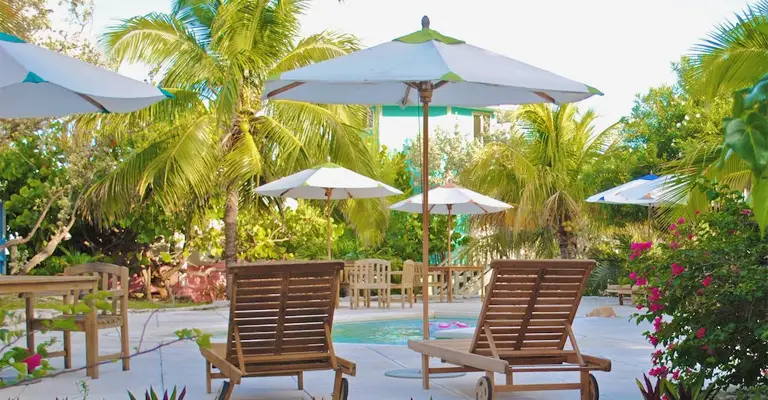
Using an umbrella on your pool cover is another excellent preventative measure. This way, the pool cover can be kept dry, allowing precipitation to run off.
Keeping it away from the plastic prevents it from soaking into the material and causing it to sag.
It is also possible to create shade over your swimming pool with the help of an umbrella attached to the cover.
2. Use A Pool Safety Cover
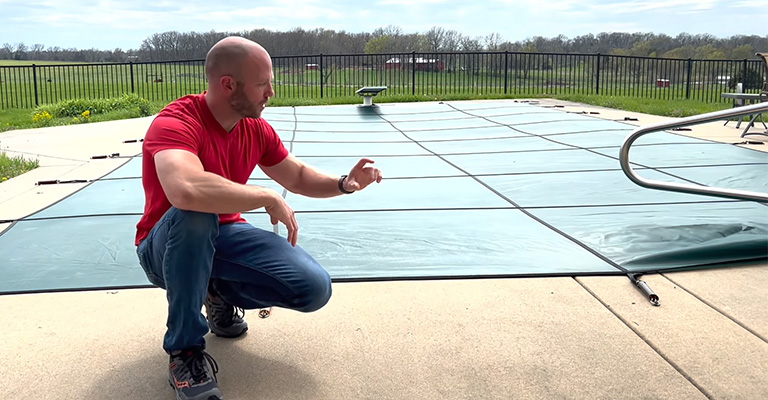
Additionally, pool safety covers prevent your pool cover from sagging and ensure that your sparkling pool stays sparkling by blocking out dirt and debris.
Due to their design, they keep air pockets at bay, which prevents a sagging pool cover. Despite their cost, pool safety covers maintain their effectiveness for long and keep children and animals safe.
3. Use H2O Bags
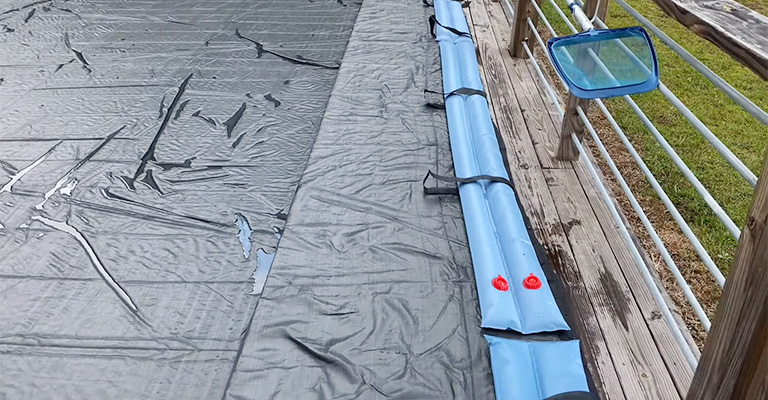
You should fill your H2O bags to almost three-quarters full. Having the bags adequately filled will make your pool cover heavier, which will help it prevent sagging.
Keeping the pool cover secure is therefore essential. You should only fill your H20 bags three-quarters full to prepare for freezing. The water bags will inevitably break if they freeze after they have been filled with water.
4. Use Pool Pillows
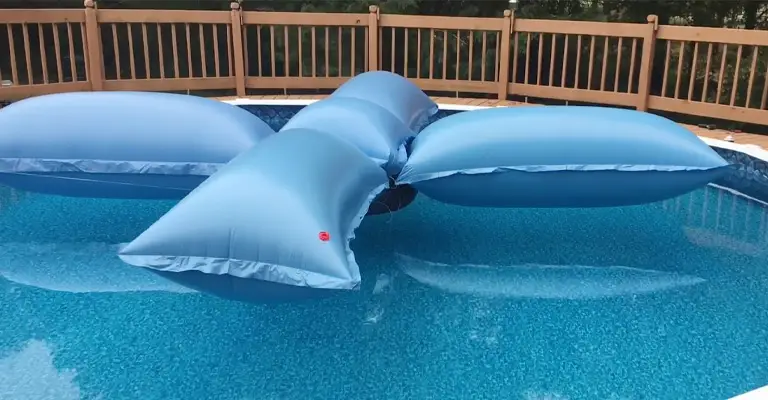
Keep your pool cover from sagging by using an extra-large pool pillow at least a third the size of your pool cover.
You should remember that pool pillows lose their shape over time and after prolonged exposure to sunlight. Occasionally, you’ll need to replace them.
5. Build A Support Structure
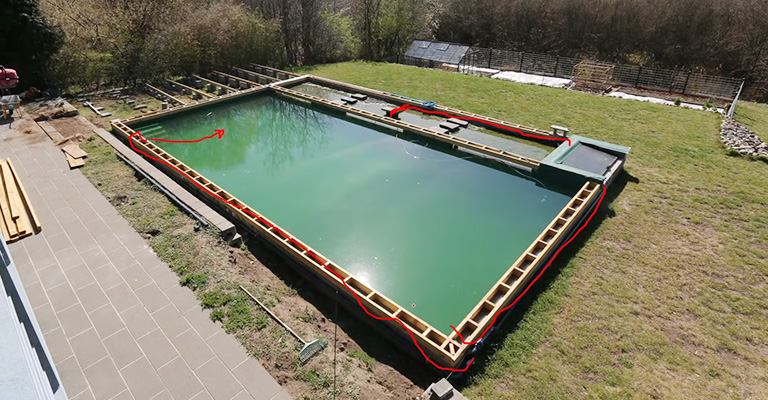
If the other methods haven’t worked, adding a support structure might be the way to go.
An extra pole should be positioned across the middle of your pool, and two crossbars should be created for a successful support structure.
Additionally, this method can keep above-ground pool covers from sagging.
6. Opt For A Portable Pool Cover
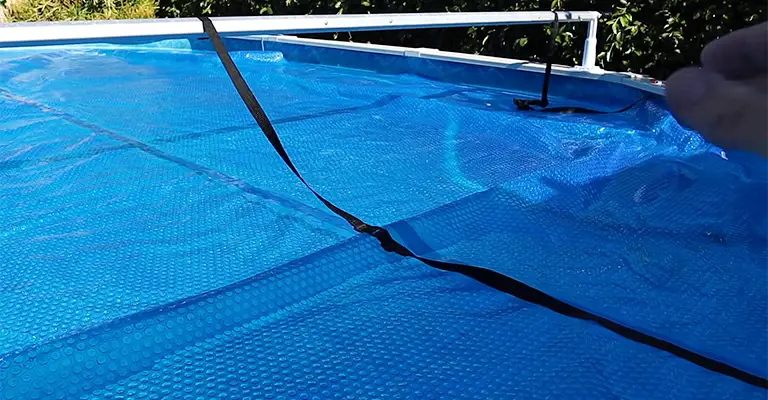
A portable pool cover easily fits securely around the pool and is unlikely to sag. They are portable, thus making them easier to manipulate.
7. Fix It As Soon As You See It
You must fix your sagging pool cover as soon as you notice it. By doing this, you will ensure that the damage does not become too severe so that it becomes impossible to repair.
8. Use Heavy Objects To Keep The Edges In Place
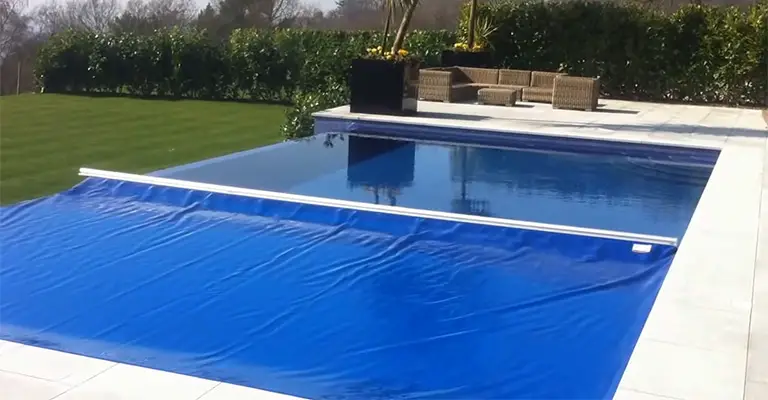
You should add weight to the outside edges of your pool cover so it will not sag. The width and length of your pool can be lined with heavy objects such as water bags of the correct gauge.
9. Keep The Middle Section Of Your Pool Cover Higher Than The Sides

Your pool cover should be raised at the center compared to the sides to eliminate water collection. Think about the shape of a roof.
Unless your pool cover adopts a similar shape, it is bound to develop a weighted dip in the middle. This is an excellent method to try out for anyone who wants to keep water off the pool cover!
How To Spot A Sagging Pool Cover?
When you see a sagging pool cover, you should act immediately.
By leaving the problem to worsen over time, you will have a much more difficult time fixing it. If you want to ensure that your pool cover is in good shape, how should you go about it?
Keep a close eye on your pool cover each week for any signs of sagging. You should look for any dips in your pool cover towards the center of the pool.
Water build-up near the dip of your pool cover, regardless of the water level in your pool and whether it has been installed correctly, can indicate a problem.
If you want to inspect your pool cover accurately, make sure you remove any debris and dirt that has built up.
Don’t forget about the condition of your pool cover as well. An old or worn-out dress has a higher chance of tearing and other damage that could lead to it sagging.
What Causes A Saggy Pool Cover?
Your pool cover can sag for several reasons. This is quite a common problem, but luckily, it is relatively easy to resolve. Pool covers tend to sag for these reasons:
Poor Installation
A poorly installed pool cover will likely be loose around the edges, making it easier for water to pull it down.
Build Up Of Dirt And Debris
A windy area will likely have a lot of leaves, dirt, and debris flying around your yard. You will be weighing down your pool’s cover if it is not regularly cleaned and removed.
It is not just dirt and debris that can add weight to your pool cover; it can also cause algae to grow.
Damage
It is very common for a damaged pool cover to allow water to seep through and accumulate, resulting in a sagging and weighed-down cover.
Low Water Level
Ideally, your pool cover should be touching the surface of your pool’s water, so you should ensure the water level is adequate.
Not Adjusting Cover Straps When Needed
There may be a temptation to put off adjusting your pool safety cover straps during the winter, but the consequences could be severe!
You can protect your pool during the off-season by fitting the cover properly with adjustable straps.
Furthermore, it is crucial to take additional care around wintertime because temperatures are low, and many of these covers are sensitive to temperature changes.
Checking the straps on your pool cover regularly can prevent sagging and pooling of water if the cover straps aren’t appropriately secured.
Snow
The snow on your pool cover must be cleared regularly since it is heavy and stretches its material.
As well as the type of snow, the soil type needs to be considered. You may have to remove ice crystals more frequently than snowflakes, and your cover may sag as a result.
A net, ice-melting agents, and de-icing chemicals are the most common methods of removing ice crystals.
Insufficient Rainwater Drainage
Draining rainwater properly is crucial to keeping a pool cover taut, wrinkle-free, and undamaged. Covers can sag without enough drainage, making them difficult to maintain and costing pool owners more time and money.
When drainage is poor, standing water can accumulate on top of the pool cover over time, eventually causing damage. Long-term wear and tear will result in costly repairs and replacements.
What Are The Different Types Of Pool Covers?
Standard Winter Covers
Because they’re made of polyethene, standard winter covers are called tarp covers. Most of the time, these covers are used in the winter. By blocking dirt and leaves, they maintain the cleanliness of your pool.
Generally speaking, it is easy to weigh down a winter pool cover since they aren’t very heavy and don’t need much weight to do so.
Safety/Security Covers
Various types of safety covers are available, including mesh and solid models. Besides supporting a lot of weight, mesh pool covers prevent dirt, leaves, and debris from getting inside the pool.
Almost all solid safety covers are similar to fluid safety covers but keep out UV rays and reduce evaporation.
Solar Covers
There is no doubt that solar covers are one of the most popular pool covers. A solar cover uses heat naturally existing from the sun and doesn’t require electricity or fuel.
Moreover, they work well when it comes to heating your pool efficiently and saving you energy and money. The only drawback to these covers is that they aren’t designed to protect against falls.
What Do You Put Under A Pool Cover?
Air pillows can protect your pool cover. It is possible to prevent water from pooling in the middle of your cover using air pillows.
You can prevent the cover from sagging or getting torn by ensuring that the water’s weight is evenly distributed around the air pillows.
Should My Pool Cover Touch The Water?
There should be water touching your pool cover. Covers for swimming pools are made to touch the surface of the water they cover.
You should never allow the water level in your pool to drop below 18 inches from the top, and you must fill it whenever it’s covered.
What Can I Use Instead Of A Pool Pillow?
Pool pillows are not the only option that works. There are many other alternatives as well. Using objects such as tires, yoga balls and regular inner tubes is possible.
Final Words
So, what’s the best way to keep pool covers from sagging? In this article, I have covered all you need to know about checking your pool cover and how to fix it.
The simple and easy solutions above are sure to resolve your sagging pool cover with ease and comfort.






